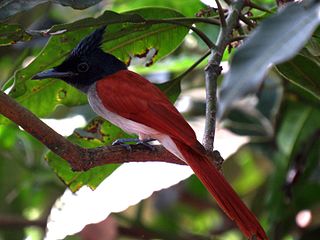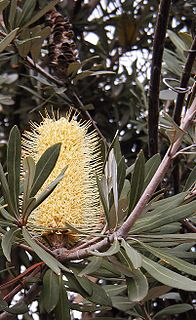
In biological classification, the term subspecies refers to one of two or more populations of a species living in different subdivisions of the species' range and varying from one another by morphological characteristics. A single subspecies cannot be recognized independently: a species is either recognized as having no subspecies at all or at least two, including any that are extinct. The term is abbreviated subsp. in botany and bacteriology, ssp. in zoology. The plural is the same as the singular: subspecies.

In biology, a subgenus is a taxonomic rank directly below genus.
An ethnonym is a name applied to a given ethnic group. Ethnonyms can be divided into two categories: exonyms and autonyms, or endonyms.

Banksia integrifolia subsp. integrifolia is a subspecies of Banksia integrifolia.

Banksia ser. Banksia is a valid botanic name for a series of Banksia. As an autonym, it necessarily contains the type species of Banksia, B. serrata. Within this constraint, however, there have been various circumscriptions.
Banksia ionthocarpa is a shrub endemic to Western Australia. It was known as Dryandra ionthocarpa until 2007.

Banksia splendida, commonly known as Shaggy Dryandra, is a shrub endemic to Western Australia. It was known as Dryandra speciosa until 2007.

Eucalyptus tereticornis is a species of tree native to eastern Australia. E. tereticornis has several common names, including forest red gum, blue gum, flooded gum, grey gum, mountain gum, Queensland blue gum, red gum, bastard box, red ironbark, red irongum and slaty gum.

Banksia subser. Banksia is a valid botanic name for a subseries of Banksia. It was first used by Kevin Thiele in 1996, although as an autonym it is not considered to have been published per se. It was discarded by Alex George in 1999.
Fali, or Fali of Mubi after the local city, is a Chadic dialect cluster spoken in Nigeria, in Adamawa State in the Mubi North and Michika LGAs. It is one of several languages in the area that go by the generic name Fali.
Banksia rufa subsp. rufa is a subspecies of Banksia rufa. It was known as Dryandra ferruginea subsp. ferruginea until 2007, when Austin Mast and Kevin Thiele sunk all Dryandra into Banksia. Since the name Banksia ferruginea had already been used, Mast and Thiele had to choose a new specific epithet for D. ferruginea and hence for this subspecies of it. As with other members of Banksia ser. Dryandra, it is endemic to the South West Botanical Province of Western Australia. As an autonym, it is defined as encompassing the type material of the species.
Banksia dallanneyi subsp. dallanneyi is a subspecies of Banksia dallanneyi. It was known as Dryandra lindleyana subsp. lindleyana until 2007, when Austin Mast and Kevin Thiele sunk all Dryandra into Banksia. Since the name Banksia lindleyana had already been used, Mast and Thiele had to choose a new specific epithet for D. lindleyana and hence for this subspecies of it. As with other members of Banksia ser. Dryandra, it is endemic to the South West Botanical Province of Western Australia. As an autonym, it is defined as encompassing the type material of the species.

Yongsheng County is located in the northwest of Yunnan province, China. It is under the administration of the prefecture-level city of Lijiang.
In zoology, the Principle of Coordination is one of the guiding principles of the International Code of Zoological Nomenclature.
The Nisoish languages, which contains both the Northern Loloish and Southeastern Loloish branches, are a branch of the Loloish languages proposed by Lama (2012). Northern Loloish and Southeastern Loloish were established by Bradley (1997), while the Nisoish group combining Bradley's two branches was proposed by Ziwo Lama (2012). Lama (2012) refers to Northern Loloish as Nisoid or Nisu–Lope, and Southeastern Loloish as Axi–Puoid.

Gepo is a Loloish language of Yunnan, China spoken by 100,000 people. The speakers' autonym is, while the "-po" of "Gepo" means 'people'. It is spoken in 6 villages of Fumin County, eastern Luquan County, and other adjacent counties to the northeast.
Tanglang, or Tholo, is a Loloish language spoken by 947 people in 8 villages of southern Tai'an Township 太安乡, Lijiang County, Yunnan, including in Hongmai 红麦 and Shuijing 水井村 villages. Tanglang has been in long-term contact with Bai, and is also in contact with Naxi. The speakers' name for the language is.
Aluo is a Loloish language spoken by the Yi people of China. It is also known by its Nasu name Laka.
Musa beccarii is a species of wild banana, found in Malaysia, in Sabah. It is placed in section Callimusa. The flower bud is narrow, bright scarlet with green-tipped bracts. The fruit is green and thin. The species is named after Italian naturalist Odoardo Beccari.







